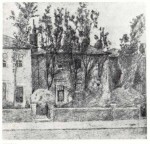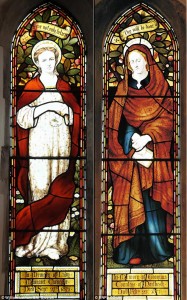 In 1876, a 23-year-old Vincent van Gogh was teaching at a small boarding school in Ramsgate, England, and living in Isleworth with the family of the Rev. Thomas Slade-Jones, Congregationalist minister and the school’s owner. It was an unpaid position with a hellish commute. He wrote to his brother Theo of his daily life teaching students Bible history and weeding the garden, of his dreams of becoming a clergyman. This was a period of increasing religious devotion for Vincent. His letters are packed full of his thoughts on Biblical passages, of his desire to spend less time teaching and more time helping Mr. Jones minister to his flock.
In 1876, a 23-year-old Vincent van Gogh was teaching at a small boarding school in Ramsgate, England, and living in Isleworth with the family of the Rev. Thomas Slade-Jones, Congregationalist minister and the school’s owner. It was an unpaid position with a hellish commute. He wrote to his brother Theo of his daily life teaching students Bible history and weeding the garden, of his dreams of becoming a clergyman. This was a period of increasing religious devotion for Vincent. His letters are packed full of his thoughts on Biblical passages, of his desire to spend less time teaching and more time helping Mr. Jones minister to his flock.
In a letter to Theo from October 7, 1876, Vincent reported walking almost six hours (!) to London to collect some school fees for Rev. Jones. While roaming the Strand neighborhood, recently rebuilt and now a home to many of the literary and artistic avant-garde, he encountered some old friends and had dinner.
After that I went to [art dealer] van Wisselingh, where I saw sketches for two church windows. In the middle of one window stands the portrait of a middle-aged lady, oh, such a noble face, with the words “Thy will be done,” over it, and in the other window the portrait of her daughter, with the words, “Faith is the substance of things hoped for, the evidence of things not seen.” There, and in the gallery of Messrs. Goupil & Co., I saw beautiful pictures and drawings. It is such an intense delight to be so often reminded of Holland by art.
 Van Gogh scholars have long searched for these church windows, and it seems they’ve finally found them in a small church, St. Andrew’s, in Owslebury, near Winchester. The two windows are almost exactly as Vincent describes them, only one inscription — “Faith is the substance of things hoped for” — was changed to “Fear not, only believe” between design and execution.
Van Gogh scholars have long searched for these church windows, and it seems they’ve finally found them in a small church, St. Andrew’s, in Owslebury, near Winchester. The two windows are almost exactly as Vincent describes them, only one inscription — “Faith is the substance of things hoped for” — was changed to “Fear not, only believe” between design and execution.
William Carnegie, 8th Earl of Northesk, commissioned the windows as memorials to his wife Georgiana and his daughter Lady Margaret as older and younger versions of the Virgin Mary. Georgiana died in 1874 at age 63, after 31 years of marriage. Margaret died in 1871 at just 23 years of age. The windows were installed in the church after his death in 1878.
Art historian Max Donnelly found the windows while researching the glazier, Daniel Cottier, and put two and two together in a serendipitous leap.
Donnelly said: “I saw a reference to them at the church in Owslebury and managed to get some photographs. It was then that bells started ringing, and it happened to be about the same time as the exhibition of Van Gogh’s letters at the Royal Academy.
“Although the letter mentioning the sketches was not among them, it reminded me that he had written to his brother.”
Donnelly contacted the earl’s descendants and was pointed in the direction of the family scrapbook. “Inside I found photographs of the people involved and photographs of the designs that Van Gogh had described,” said Donnelly. “I assume that the 8th earl sent copies to family members showing them what he was intending for the church to the memory of his wife and daughter.
“This proved that the windows were the ones Van Gogh had seen.”